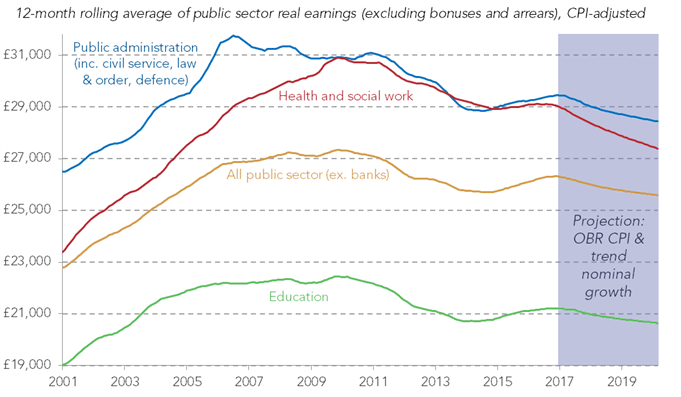
15/03/17
2 min read
A combination of rising inflation and pay restraint means that average real pay is now falling in the public sector, and is expected to continue falling over the next three years, according to Resolution Foundation’s latest Earning Outlook published today.
Forecasts released by the OBR last week showed that overall pay growth could turn briefly negative later this year. However the Resolution Foundation’s new analysis, which is funded by the Nuffield Foundation, shows that this decline has already begun in the public sector – which employs one in six workers – and is set to continue until at least 2019.
The Resolution Foundation finds that although real pay performed well in 2015 and 2016, this was largely due to prices not rising at a time of public sector pay restraint. With inflation now increasing, the analysis shows that real public sector pay is likely to have started falling in the three months to February. Private sector pay continued to grow over the same period.
With the growth in public sector paybills limited again to 1 per cent for the next three years, real pay is forecast to continue to fall for the rest of this decade. The Resolution Foundation forecasts that average real pay in the public sector will fall back below 2004-05 levels by the end of the parliament (2019-20).
On current pay trends, average pay in the public sector would be £1,700 lower in 2019-20 than its peak in 2009-10. The Resolution Foundation notes, however, that the very lowest earners will be protected from falling earnings due to large and welcome planned increases in the National Living Wage.
The Resolution Foundation says that pay growth has been particularly weak in health and social work, and could fall a further 6 per cent by 2019-20. This could make it hard to recruit new workers and provide sufficient care for an ageing population, despite the government’s welcome announcement of a £2bn funding boost in last week’s Budget.
Pay in public sector education was lower in 2016 than in 2003, the analysis shows, and is expected to fall a further three per cent. Average pay in the public administration sector (which includes most other public sector roles), is also expected to fall a further three per cent and be no higher in 2019-20 than in 2003.

Adam Corlett, Economic Analyst at the Resolution Foundation, said:
“While rising inflation is applying the brakes to real pay growth across the board, the outlook for public sector pay looks particularly weak. Pay is now actually falling, and worst is expected to continue for the rest of the parliament, with levels at the end of the parliament dropping back to levels last seen in 2004.
“Although public sector pay restraint is important to the government’s deficit reduction plans, falling real pay is likely to see increasing recruitment strains. The government should be planning now how to manage those strains, alongside any wider changes to policies like migration that will also have an impact.”






















































